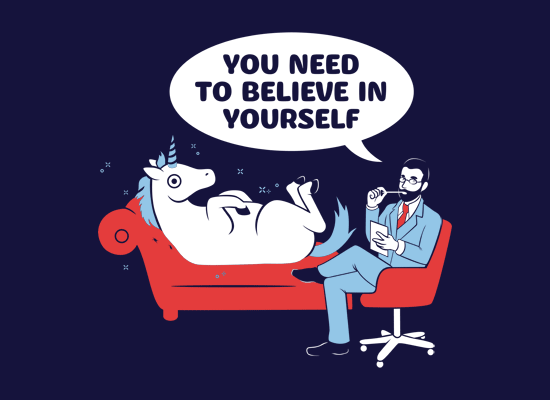Tech companies, specifically those in growth mode, have a really bad habit of chasing top-line metrics. More revenue! More users! More, more, more!
“But what about our bottom line?”
“Doesn’t matter! Just keep getting more users!”
It drives me nuts and makes me want to scream.
I know why they (dare I say ‘we?’) do it. But it’s not the right thing to do…if you’re looking to build a company to last.
Revenue vs. profit is an argument as old as time…well, 2001 I guess. That’s when we all got the first slap in the face. “What do you mean this tech company isn’t worth anything anymore? Sure, they’re not turning a profit and don’t really have a business model, but they went public, so I should have doubled my money in under a week.”

Benjamin Graham’s The Intelligent Investor should be standard reading.
The question has always been, “If you aren’t in business for fun & profit, what are you doing here?” The answer nowadays?
“I’m here to exit. Period.”
Maybe it’s just me, but I feel a sense of social responsibility to do things the right way. To me, building a company on revenue with complete disregard to profit (the real indicator of health and longevity) is like building your cabin in Telluride out of matchsticks and gasoline. It’s the same thing as lying to yourself and your investors.
BUT….
If you sell that cabin before it catches on fire, it’s not your problem anymore, is it?
THAT, ladies and gentlemen, is why this bubble is different. 2001 made us smarter. This time around, we’re going to 1) sell the car on Craigslist without disclosing all the maintenance problems, or 2) just commit flat-out insurance fraud. “Oh, the motor blows up if you don’t put oil in the engine? No, I had no idea. Can I get my payout?”
The sad part about all of this is, you CAN have both
…just not as quickly as you may like. At the end of the day, business valuations come down to profitability and growth metrics. The latter is the easy part, which is why so many companies shoot for user acquisition and revenue growth. Money solves both of those. Want more users? Spend more to get ’em. Problem solved. But what happens when the money runs out and you realize you didn’t lay the processes to make the business profitable? Or you find out your LTV is lower than your CAC?
Oops. (Or should I say, “pop!”)
Laying the groundwork for a profitable business is hard work. You have to make sure customers are actually happy, give them the resources and support they need to be successful, and deliver on the value you promised them. You have to cross-sell and up-sell to get deeper share of wallet and get your LTV swol (bro!). You have to fine-tune your internal operations, watch your spending and forego Beer Fridays at times.
Britney said it best. “You. Betta. Work.”
Not all tech companies are guilty of this. Throwing money at expansion is okay, so long as you’re also (aware of, and) investing in areas that will allow your business to scale profitably. Growth creates more growth, in other areas. Don’t ignore that. Approach this as filling up your first house with furniture, not giving your kids a credit card. There’s right and wrong ways to do this, as well.
The trick is, once the cash stops coming in from people who are basically not customers, money has to start coming in at a pretty good clip from people the companies actually sell things to. Otherwise, when unicorns show up to Wall Street in an ’emperor has no clothes’ fashion, the market is going to say, “bye Felicia.” That’s why keeping (paying) customers around is so important. They’re your lifeblood.
Okay, I’m repenting (or want to help fight this!). Where do I start?
Churn. Kill it with retention. Managing both of these factors lets you build something to last (because customers aren’t flying out the door as fast as you’re selling them in).
What do you need to retain customers? (Figurative) fireworks. Think July 4th, people. As soon as your customers (guests) roll into your BBQ, there had better be hot dogs, burgers, cold beer and sparklers. But you can’t stop there; everyone really came for the fireworks. Your show needs a beginning, middle and end. And you need to nail each part to make it a great show. You can’t be like San Diego in 2012 and accidentally give them everything at once. (I was there, it was hilarious and disappointing all at the same time.)
Phase 1: Get them to the “Ah-ha!” moment (short term)
In the first week (or month, in some cases), your users need to experience the core value you promised. Half of the cancel requests I see are usually some variation of “I haven’t had time to start.” This really means, “you idiots didn’t make it easy enough for me to get started.” Crappy companies counter with, “Wow, our customers are dumb.” Good companies consider it their fault and fix it.
Sometimes you have to kindly hassle your customers to achieve usage. Just make sure you do it the right way.
Phase 2: Help them build habits (medium term)
Phew! You blew up their skirt in the first week. Or, even better, you helped the customers blow up their own skirts by taking certain actions. Key to medium-term happiness? Get your customers to keep doing the things that blow their skirts up. Don’t think that just because they did it once, they’ll keep doing it on their own. Be their Pavlov. Incentivize repetition.
Phase 3: Don’t let things fizzle out (long term)
Congrats, you’re married! Your customers have stayed this long. How do you keep them staying? Buy them flowers on the reg. Your job isn’t done. Keep delivering and reminding your customers of the value they’re getting. Send them a system email encouraging them to continue taking action. Delight them with something unexpected. Make them feel special. At Infusionsoft, we have a Random Acts of Delight program. You’d be amazed at how tickled people get over a small gift or words of encouragement that required a minimal investment of time or money on our part.
Retention needs to be proactive, not reactive
Later, we’ll take a look at great examples of hooks and other tactics you can use to keep your customers around. For now, focus on adopting your newfound worldly views of customer lifecycle management, a better growth strategy and making retention a fun challenge instead of a chore.

